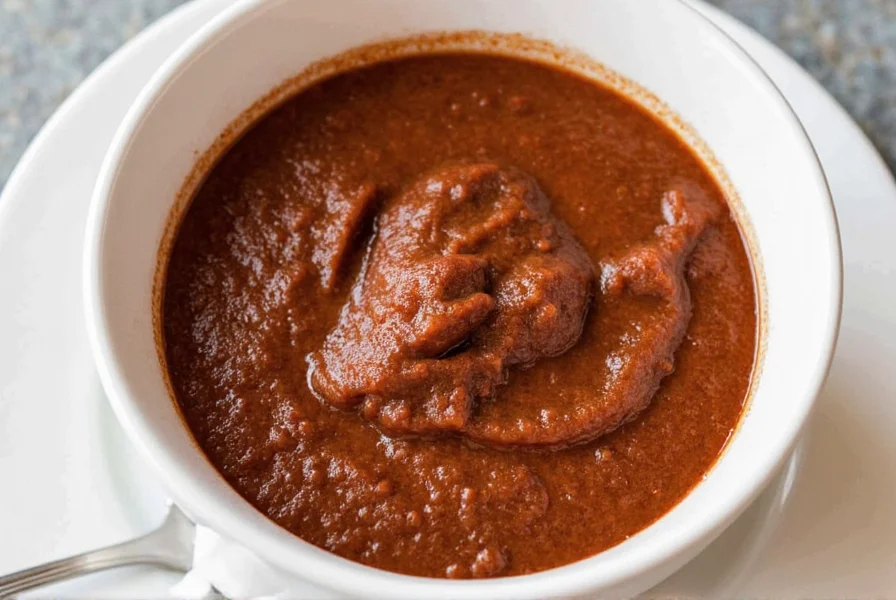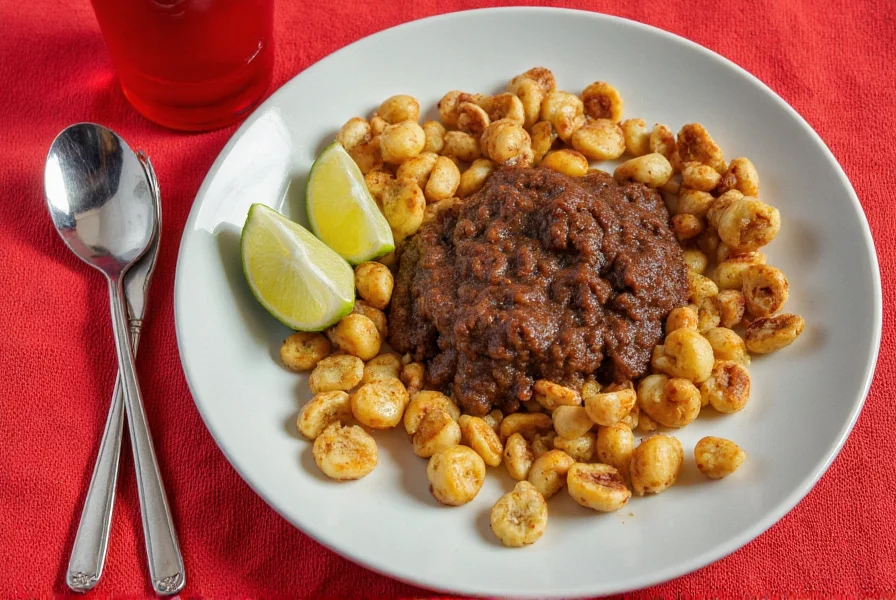Mole dulce (literally 'sweet mole' in Spanish) is a dessert-like variation of traditional Mexican mole sauce characterized by its rich sweetness from ingredients like dried fruits, honey, cinnamon, and nuts instead of the typical chili heat found in savory moles. Unlike mole negro or mole poblano, mole dulce contains minimal to no heat, making it perfect for desserts, sweet glazes, and unique culinary applications.
This authentic Mexican sweet sauce originates from regions like Puebla, Oaxaca, and Tlaxcala, where it's traditionally served during celebrations such as weddings and holidays. In this comprehensive guide, you'll learn exactly what makes mole dulce unique, how to make it from scratch, where to buy authentic versions, and seven creative ways to use this versatile sauce in both sweet and savory dishes.
Table of Contents
- What is Mole Dulce? (Definition and Origins)
- Mole Dulce Flavor Profile: Sweet Mole Characteristics
- How to Make Mole Dulce: Authentic Recipe Steps
- 7 Creative Mole Dulce Uses in Cooking
- Mole Dulce vs Mole Negro: Key Differences Explained
- Where to Buy Mole Dulce: Best Store-Bought Options
- Mole Dulce FAQ: Your Top Questions Answered
- Conclusion: Why Mole Dulce Belongs in Your Pantry
What is Mole Dulce? (Definition and Origins)
The term "mole" comes from the Nahuatl word *molli*, meaning sauce or mixture. While traditional mole recipes feature chili peppers, spices, and chocolate with varying heat levels, mole dulce focuses primarily on sweetness. This authentic Mexican sweet sauce is a specialty of central Mexico, particularly in Puebla, Oaxaca, and Tlaxcala regions.
Mole dulce features ingredients like dried fruits (raisins, prunes, figs), honey, piloncillo (unrefined cane sugar), almonds, sesame seeds, cinnamon, and sometimes even plantains. It's traditionally prepared for special occasions including weddings, religious festivals, and holiday celebrations. The resulting sauce has a smooth, pudding-like consistency and a complex sweet flavor profile without significant heat.
Mole Dulce Flavor Profile: Sweet Mole Characteristics
Mole dulce offers a distinctive flavor experience that differs significantly from traditional savory moles. Here's what makes it unique:
- Prominent Sweetness: Derived from natural sources like dried fruits, honey, and piloncillo without artificial sweeteners
- Nutty Complexity: Toasted almonds or sesame seeds provide rich, earthy notes
- Warm Spices: Cinnamon, anise, and cloves add depth without heat
- Fruity Undertones: Raisins, prunes, and sometimes apples create jammy, complex layers
- Velvety Texture: When properly prepared, it has a smooth, thick consistency similar to dessert sauce
How to Make Mole Dulce: Authentic Recipe Steps
Creating authentic mole dulce requires attention to detail but yields impressive results. Here's a traditional preparation method:
- Toast Ingredients: Lightly toast 1 cup almonds, 1/2 cup sesame seeds, 3 cinnamon sticks, and 1 teaspoon anise seeds in a dry skillet until fragrant
- Soak Dried Fruits: Cover 1/2 cup raisins and 1/4 cup prunes with warm water or apple cider and let soak for 30 minutes
- Prepare Sweet Base: Dissolve 1 cup piloncillo in 1 cup water over medium heat, stirring until fully dissolved
- Blend Everything: Combine toasted ingredients, soaked fruits, sweet base, and 1/4 teaspoon salt in a blender until smooth
- Cook Down: Transfer to a saucepan and simmer over low heat for 25-30 minutes, stirring frequently until thickened to desired consistency
- Adjust Seasoning: Add orange zest or additional cinnamon to taste

7 Creative Mole Dulce Uses in Cooking
Mole dulce's versatility extends far beyond traditional applications. Try these creative uses:
- Churro Dip: Serve warm as a dipping sauce for churros (the Mexican dessert equivalent of chocolate fondue)
- Breakfast Upgrade: Pour over pancakes, waffles, or French toast as a gourmet alternative to maple syrup
- Meat Glaze: Brush on pork tenderloin or chicken during the last 10 minutes of cooking for a sweet-spiced crust
- Dessert Topping: Drizzle over vanilla ice cream, bread pudding, or rice pudding
- Cheese Pairing: Serve with queso fresco or goat cheese and crackers for an elegant appetizer
- Baking Ingredient: Swirl into brownie batter or layer between cake tiers for added moisture and flavor
- Morning Boost: Stir a spoonful into oatmeal or yogurt for a flavor-rich breakfast
Mole Dulce vs Mole Negro: Key Differences Explained
To understand where mole dulce fits in the mole family, here's how it compares to other popular varieties:
| Type | Main Flavor Profile | Heat Level | Sweetness Level | Best Uses |
|---|---|---|---|---|
| Mole Negro | Deep chocolate, complex chilies, smoky | High (3-5 chilies) | Low (trace chocolate sweetness) | Tamales, turkey, chicken enchiladas |
| Mole Verde | Fresh herbs, tomatillo, green chilies | Medium (2-3 chilies) | Negligible | Chicken, seafood, vegetable dishes |
| Mole Dulce | Sweet fruits, warm spices, nutty | None to Very Low | High (primary characteristic) | Desserts, sweet glazes, dips, breakfast |
| Mole Poblano | Chocolate, mild chili, complex spices | Medium (2-3 chilies) | Low (chocolate notes) | Festive occasions, chicken dishes |
| Mole Amarillo | Tomatillo, corn, mild chili | Medium-High | None | Oaxacan street food, tacos |
Where to Buy Mole Dulce: Best Store-Bought Options
When you need a quality ready-made option, these are the top mole dulce products available:
| Product Name | Key Features | Why Choose This | Ideal For | Purchase Locations |
|---|---|---|---|---|
| Don Arturo Mole Dulce | Authentic Puebla recipe, no preservatives | Best overall balance of traditional flavor | First-time users, special occasions | Mexican grocery stores, Amazon |
| La Costeña Mole Dulce | Affordable, widely available | Most accessible supermarket option | Everyday cooking, family meals | Walmart, Target, major supermarkets |
| Los Amigos Gourmet Mole Dulce | Premium ingredients, artisanal production | Most authentic restaurant-quality flavor | Special dinners, gifting | Specialty food stores, online retailers |
| MexGrocer Organic Mole Dulce | Certified organic, vegan-friendly | Best for health-conscious consumers | Organic diets, dietary restrictions | Online specialty retailers |
| El Jarocho Artisanal Mole Dulce | Small-batch, handcrafted | Most complex flavor profile | Chef-quality cooking, special occasions | High-end grocery stores, Mexican specialty shops |
Mole Dulce FAQ: Your Top Questions Answered
What is the difference between mole dulce and regular mole?
Regular mole varieties like mole negro focus on complex layers of chili peppers, spices, and chocolate with varying heat levels. Mole dulce flips this formula by emphasizing sweetness as its primary characteristic. It contains significant amounts of dried fruits, honey, piloncillo, and warm spices like cinnamon, with minimal to no chili heat. The texture is also typically smoother and thicker, resembling a dessert sauce rather than a savory gravy.
Is mole dulce actually sweet?
Yes, mole dulce ('dulce' means 'sweet' in Spanish) is intentionally and significantly sweet. Authentic versions contain generous portions of natural sweeteners like piloncillo (unrefined cane sugar), honey, and dried fruits. While it does contain some traditional mole spices, the dominant flavor profile is sweet rather than spicy. The sweetness level typically ranges from moderate to high, depending on the specific recipe.
Can mole dulce be used in savory dishes?
Absolutely. While primarily sweet, mole dulce's complex flavor profile makes it surprisingly versatile in savory applications. It works exceptionally well as a glaze for pork tenderloin, chicken thighs, or even salmon. Many Mexican chefs use it to balance overly acidic dishes or to add depth to vegetarian mains. The sweet-spice combination creates a sophisticated flavor dimension that enhances rather than overwhelms savory ingredients.
How long does homemade mole dulce last?
Properly stored in an airtight container, homemade mole dulce will keep for 5-7 days in the refrigerator. For longer storage, freeze it in portion-sized containers for up to 3 months. Commercially prepared mole dulce typically has a shelf life of 12-18 months unopened, and about 1-2 weeks after opening when refrigerated. Always check for signs of spoilage like mold, off smells, or separation that doesn't recombine with stirring.
Where can I buy authentic mole dulce?
Authentic mole dulce can be found at Mexican grocery stores (particularly those specializing in Puebla or Oaxacan products), Latin American food markets, and increasingly in mainstream supermarkets with robust international sections. Online, specialty retailers like MexGrocer, iGourmet, and Amazon carry multiple authentic brands. Look for products listing specific Mexican regions (Puebla, Oaxaca) on the packaging for the most authentic options.
Is mole dulce gluten-free?
Most traditional mole dulce recipes are naturally gluten-free, as they're made from ingredients like nuts, seeds, spices, dried fruits, and sweeteners. However, some commercial products may contain thickeners or be processed in facilities that handle gluten. Always check the label for 'gluten-free' certification if you have dietary restrictions. For absolute certainty, making it at home allows complete control over ingredients.
How do I make mole dulce less sweet?
If your mole dulce is too sweet, you can balance it by adding a pinch of salt, a squeeze of fresh lime juice, or a small amount of unsweetened almond milk. For cooking applications, try combining it with a small amount of unsweetened mole negro to create a custom sweet-savory blend. When using it as a dessert topping, pair it with tart elements like fresh berries or citrus segments to balance the sweetness.
What does authentic mole dulce taste like?
Authentic mole dulce offers a complex symphony of flavors: rich toasted nuts (typically almonds), warm spices (cinnamon, clove, anise), and deep fruit sweetness from raisins and prunes. It has a smooth, velvety texture with subtle earthiness from sesame seeds. Unlike artificial sweet sauces, authentic mole dulce achieves its sweetness naturally through ingredient combinations, resulting in layered flavors that evolve on the palate rather than a one-note sugary taste.
Conclusion: Why Mole Dulce Belongs in Your Pantry
Mole dulce offers a delightful twist on traditional Mexican mole, bridging the gap between savory cuisine and sweet dessert applications. Its unique flavor profile—rich with toasted nuts, warm spices, and natural fruit sweetness—makes it one of the most versatile sauces you can keep in your culinary arsenal.
Whether you're making it from scratch using traditional methods or selecting a high-quality store-bought version, mole dulce opens up creative possibilities from breakfast to dessert. It transforms ordinary dishes into extraordinary culinary experiences with minimal effort. As interest in authentic Mexican cuisine continues to grow worldwide, understanding and utilizing sweet mole varieties like mole dulce helps preserve and appreciate the full spectrum of Mexico's rich culinary heritage.
Ready to elevate your cooking? Start with a small batch of mole dulce and discover how this sweet sauce can transform your favorite recipes in unexpected and delicious ways.











 浙公网安备
33010002000092号
浙公网安备
33010002000092号 浙B2-20120091-4
浙B2-20120091-4